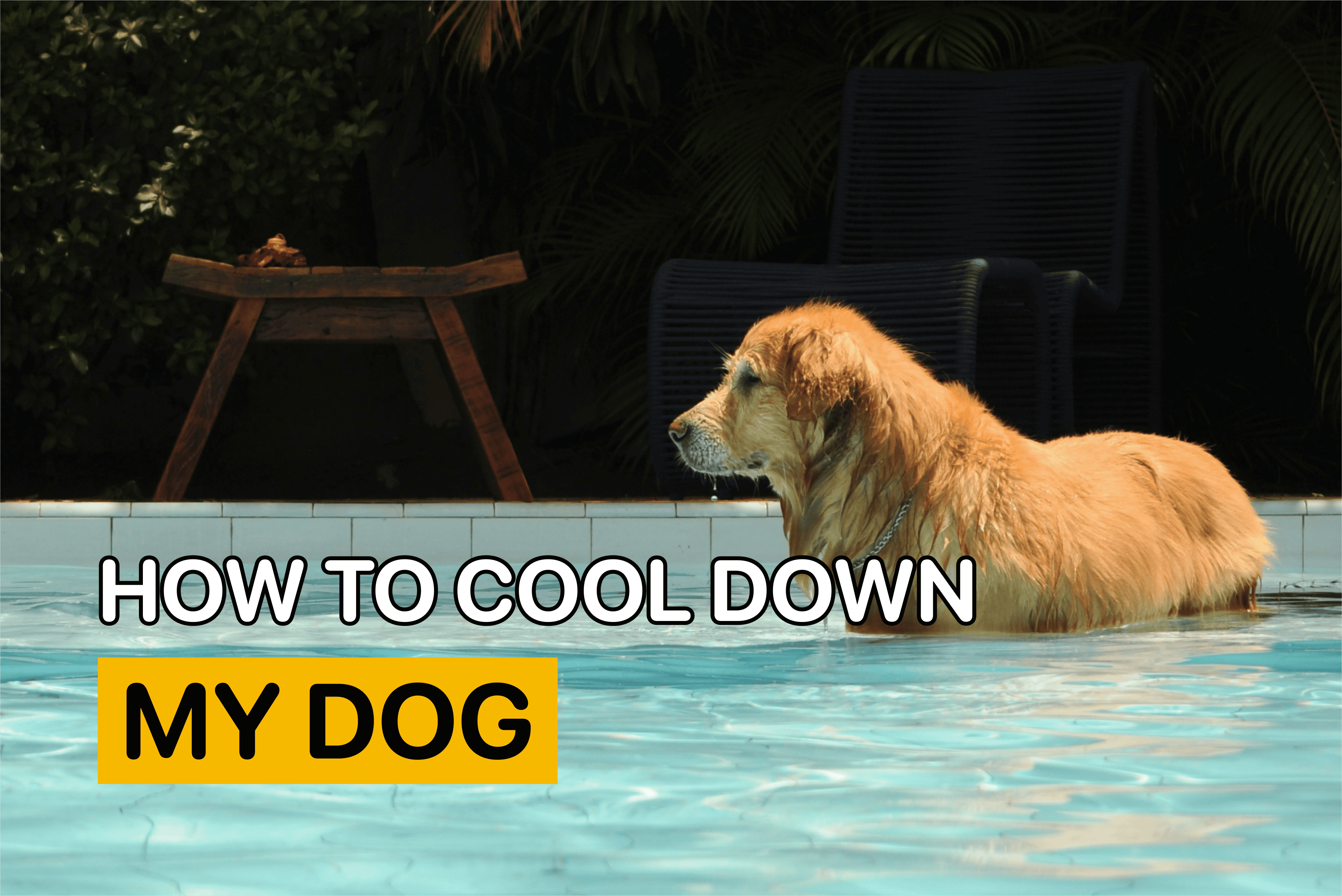What to Do if Your Dog Is Overheated? Preventing Overheating in Dogs

By
Woofz Team Updated on |Reviewed by
Karen PiwinskiWhen summer comes, you may find it difficult to resist the temptation to spend more time outdoors walking your furry companion. Indeed, quality walks outside provide a dog with an excellent opportunity for physical and mental exercise. However, pet owners should keep in mind that canines are more susceptible to heatstroke than humans, which can develop into a potentially fatal condition.
If you're wondering how to tell if your dog is overheating, how to help them cool down effectively, and how to keep them safe during a heatwave, this is the right place to start.
What Is Overheating in Dogs?
Unlike humans, dogs have a less efficient mechanism for cooling down their body temperature in hot weather. Though they do have sweat glands in their paws, they don’t play a significant role in body temperature regulation. Instead, canines use panting to release heat or dig up the ground to find cooler soil in which to lie and decrease their body temperature.
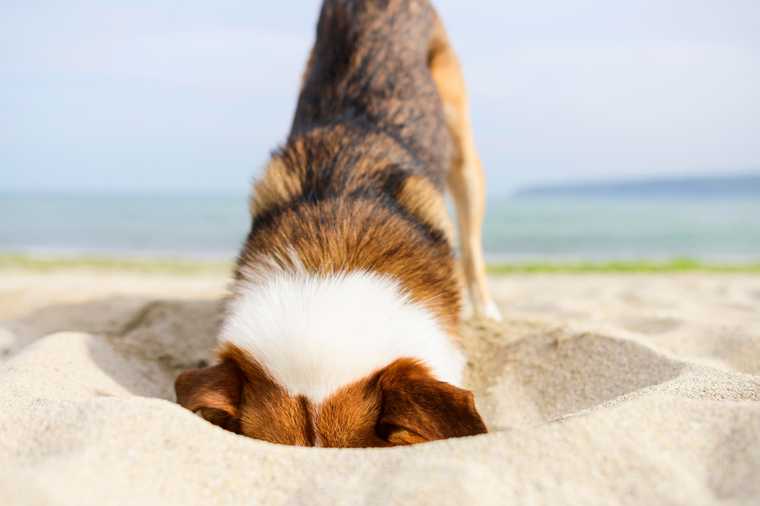
However, these mechanisms have disadvantages. If extreme heat is paired with high humidity, panting becomes less effective. Additionally, walking a dog under direct sunlight or on a concrete sidewalk (which also gets hot) deprives them of the opportunity to use their environment to regulate their core body temperature naturally.
Some dogs are more prone to overheating than others. They are:
- Senior dogs
- Puppies
- Brachycephalic breeds
- Double-coated breeds
- Canines with black or dark coats
- Overweight dogs
Generally brachycephalic breeds are the most prone to overheating, as breathing is challenging and therefore panting to cool themselves is difficult.
When a canine’s body temperature exceeds 104°F (40°C), we can classify the condition as heat stroke or hyperthermia. The condition is dangerous since it puts a dog’s body systems at risk and can lead to organ failures or even death. That’s why any pet parent needs to know the signs and symptoms of heat stroke and when to seek medical intervention.
Symptoms and Signs of Dog Overheating

It’s easy to overlook the first signs and symptoms of an overheated dog, as they’re often vague, and inexperienced owners may mistake them for expected behaviors. On top of that, canines are often too hot in the air temperature, which is still comfortable for humans. Let’s break down the warning signs of overheating that you must be aware of.
Signs of overheating
Heat stress and exhaustion are the first stages of overheating. You’ve probably experienced it yourself when you spent too long outside on a hot summer day without a chance to hide in the shade or drink more water. Similarly, dogs at this stage start to experience physical discomfort, but these signs can be reversed if you cool your pet down immediately.
Dog overheating signs include:
-
Heavy and frequent panting: Pay extra attention to the way your furry companion breathes in hot weather. Frequent and continuous panting may be a sign of their attempt to dissipate heat.
-
Excessive drooling: Extreme salivation (often in the form of thick saliva) can be another sign, as drooling also helps cool the dog's temperature.
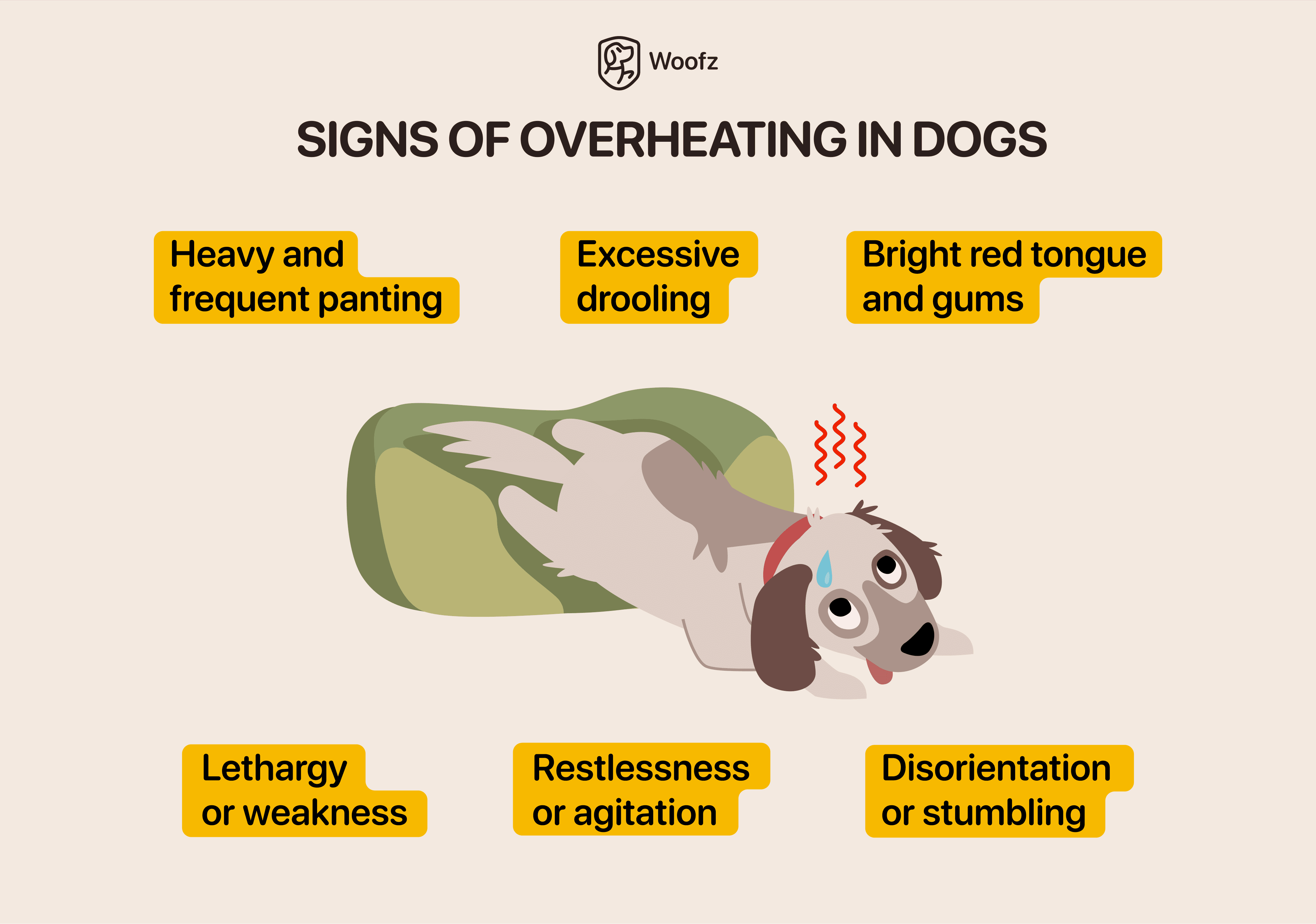
-
Bright red tongue and gums: The change in gum and tongue color (they turn bright red or even bluish) can occur due to overheating and increased blood flow to the membranes.
-
Lethargy or weakness: An overheated dog often becomes apathetic, lacks energy, and moves more slowly than usual.
-
Restlessness or agitation: Some dogs, especially during the initial phase of overheating, can become agitated, pacing around or circling in an attempt to find a comfortable position.
-
Disorientation or stumbling: As heat stress worsens, you may notice a canine start stumbling or become disoriented. These are severe symptoms that require further vet assistance.
Symptoms of a dog overheating

Unless a canine is cooled down properly and its body temperature returns to the normal range (100.5°F–102.5°F or 38.1°C–39.2°C), heat exhaustion is likely to progress to heat stroke, which is a medical emergency.
Seek veterinary assistance if your dog displays the following symptoms:
-
Elevated body temperature: A body temperature above 103°F (39.4°C) is considered hyperthermic. If it exceeds 106°F (41°C), your dog loses its ability to regulate body temperature and should be transferred to a vet immediately.
-
Increased heart rate: Extreme weather conditions put a strain on a canine’s heart, so it has to work harder to pump blood to the surface blood vessels on the skin to release excess heat.
-
Dehydration: Overheated dogs lose more water than they can replenish, so you may notice dry gums or sunken eyes.
-
Vomiting and diarrhea: Overheating in dogs can lead to gastrointestinal issues, which can worsen the detrimental impact of heat stroke as they contribute to dehydration.
-
Collapse: Collapsing is a medical emergency requiring immediate medical assistance.
-
Seizures: Extreme temperatures negatively impact all bodily organs in canines, including the brain. In some cases, this impact can present itself as seizures.
How to Help an Overheated Dog
Heat stroke in canines develops gradually. It first starts with heat stress, transitioning to heat exhaustion and heat stroke (unless you help your furry friend cool down fast and effectively). Though the duration of time needed for a dog to develop heat stroke varies depending on their tolerance to high temperatures, sometimes it may take as little as 15 minutes from the start of the symptoms to the death of the animal.
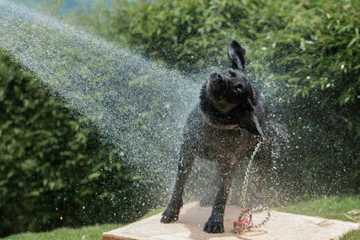
According to the Animal Emergency Service, the prognosis for a canine with heat stroke decreases by 25% for each organ affected. That’s why acting early is key to successful recovery. Let’s break down how to cool down an overheated dog.
What to do if your dog is overheated:
-
Move to a cool environment: Immediately remove your pet from a hot spot and transfer them to a shaded area to avoid direct sunlight. It’s better to bring your pet inside to a cool tile floor or a well-ventilated place with enough air movement or air conditioning.
-
Cool the dog down: Help your dog release excess body heat by gently wetting them down (use a hose or a bucket, but avoid pouring cold water on their face). Avoid placing wet towels on the dog for an extended period, as this can trap heat and exacerbate the condition.
-
Encourage drinking: Allow small sips of water, don't allow your dog to drink too much at one time.
-
Monitor the dog: Symptoms can worsen any minute, so check your dog’s state regularly to provide adequate help when needed.
-
Seek veterinary care: If you suspect your pet is suffering from heat stroke, contact a vet immediately to start medical treatment (this could include IV fluids to treat dehydration, emergency cooling, anti-nausea meds, pain relief, and more).
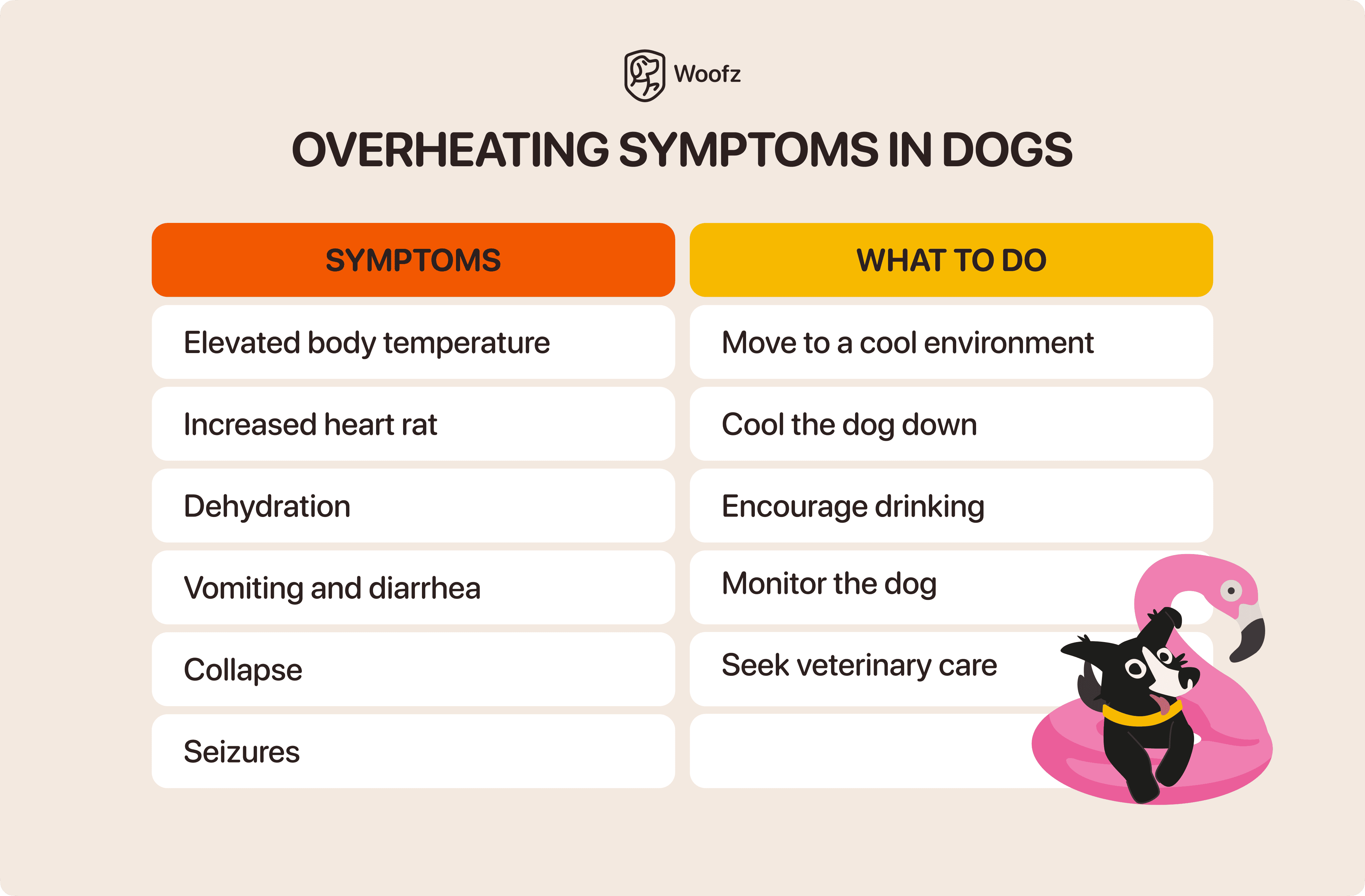
How to Keep a Dog From Overheating: 7 Preventive Measures
Once your dog is affected by extreme heat and is unable to regulate their body temperature, the impact on their organs and systems is difficult to predict. Some can recover fully, while others will suffer from permanent organ damage or may not even survive. That’s why it’s vital to prevent heat stroke before it occurs.
To keep a dog cool on a hot day, stick to the following rules:
- Keep your dog hydrated: High temperatures outside make your pet pant more frequently than usual and lose water more quickly. Considering this, you must offer more water than on a typical day.
Offer 1 ounce of water for 1 pound of your dog’s weight, or 60 ml for 1kg, respectively.
-
Limit exercise in hot weather: Consider changing your exercise routine to avoid overheating. Shift the exercise to early morning or late evening when the temperature outside drops. For brachycephalic breeds, the walks should be kept as short as possible (offer only short potty breaks in extreme heat).
-
Use a paddling pool: Help your pet cool down by offering them a swimming session in a pool. Keep the water cool but not freezing and supervise them, especially if the pool is deep.

-
Provide shade: If you spend time outdoors with your furry companion, choose a walking area with plenty of trees to provide shade and protection from direct sunlight.
-
Never leave dogs in cars: Cars parked in the sun can get extremely hot very quickly. Leaving your vehicle in the sun for 10–20 minutes can increase the temperature by 20°F (11 °C). So, never leave your pet unattended in a car, even for a few minutes.
-
Provide proper ventilation: Switch on the air conditioning or use fans to cool down the area where your pet spends long periods.
-
Let your dog rest: Reduce the time and intensity of the exercise routine on a hot day. Remember that intense training can contribute to overheating, so ensure your furry family member has a chance to rest in a shaded, well-ventilated, and cool spot.
Top 5 Dog Breeds Susceptible to Overheating
Some breeds can tolerate summer weather better than others. It often depends on their size, skull structure, and coat type. If you live in a hot climate, it can be vital to consider your dog’s genetic makeup and heat tolerance before adopting one.
Here’s our pick of the top 5 popular breeds that struggle the most when the temperature rises.
1. Pugs
Pugs’ peculiar skull anatomy makes it challenging for them to regulate their body temperature in hot weather.

Like other brachycephalic dogs, they have short and flat faces, which makes panting less efficient. Their narrow nasal passages interfere with proper airflow, and, as a result, it’s more difficult for them to evaporate excess heat.
2. Bulldogs
Bulldogs face issues similar to those pugs struggle with: limited cooling capacity due to short muzzles and narrow nasal passages.

Bulldogs may also display an inability to recognize when they get too hot, so you should be extra cautious during walks and monitor them for signs of overheating.
3. Golden Retrievers
For golden retrievers, the summer heat is particularly challenging to endure due to their thick, double coats.

It helps them stay warm in cold weather but also traps heat on a hot day. That’s why you should be mindful of the time and place you choose to walk them in when it’s hot outside.
4. Akitas
Originating from Japanese mountains, Akitas can tolerate cold relatively well, while extreme heat is dangerous for them. Their fluffy coats prevent them from releasing heat from their bodies. They also rarely sweat, so Akita owners must ensure that proper conditions are maintained during hot weather to keep them safe.
5. Alaskan Malamutes
Alaskan Malamutes are one of the breeds that are most susceptible to heat stroke. Their thick coat makes them prone to overheating quickly.

So, you must be extra cautious with your dog during hot days. It’s better to keep dogs inside when it’s too hot outdoors, limit their exercise, and arrange regular grooming to remove loose fur.
Wrap Up
Dogs' body temperature regulation differs from that of humans. As a result, they’re more prone to overheating and heat stroke, which can be dangerous to their health. That’s why responsible pet parents must recognize the signs and symptoms of overheating to act promptly and prevent potential health complications. Armed with the proper knowledge on how to help an overheated dog and avoid heat stroke, you’ll be able to enjoy summer weather with no risk for your furry companion!



